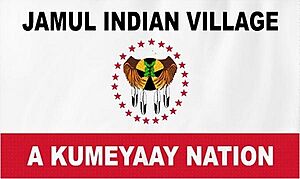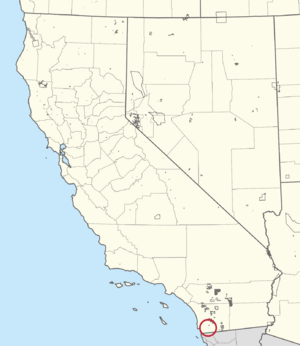Jamul Indian Village facts for kids
 |
|
| Total population | |
|---|---|
| 60–120 enrolled members | |
| Regions with significant populations | |
| United States (California) | |
| Languages | |
| Ipai, English | |
| Religion | |
| Traditional tribal religion, Christianity (Roman Catholic) |
|
| Related ethnic groups | |
| other Kumeyaay tribes, Cocopa, Quechan, Paipai, and Kiliwa |
The Jamul Indian Village of California is a federally recognized tribe of Kumeyaay Indians. These tribes are sometimes known as Mission Indians.
Contents
About the Jamul Indian Village
The Jamul Indian Village is a special area of land called a federal reservation. It is located about 10 miles (16 km) southeast of El Cajon. This area is in southeastern San Diego County, California. The reservation was officially created in 1912.
The Jamul Indian Village reservation is about 6 acres (2.4 hectares) in size. Today, no one lives directly on the reservation land. However, in the 1970s, about 20 tribal members lived there.
Language and Culture
The traditional language of the Jamul Indian Village and the larger Kumeyaay group is from the Tipai language family. Long ago, the Spanish Mission system in California tried to change the ways of Native American tribes. This made it hard for many tribal members to keep their native language.
Today, fewer than 100 tribal members still speak their native language. However, the Jamul Indian Village also uses English as their main language for talking and communicating every day.
A Look at Jamul History
The Jamul Indian Village has a very long history in California. Their ancestors began living in this area about 12,000 years ago. The tribe deeply understood their environment. They worked hard to respect and honor the land they called home.
In the past, the tribe practiced many traditions. These included basket weaving, traditional hunting, and playing games. They also used controlled fires, called cultural burnings, to help the land stay healthy. They lived in a way that kept the land balanced with what it provided.
When Europeans arrived, it brought big changes for the tribe. Many of their traditions were lost because of forced changes to their way of life. However, over many generations, the Jamul people have worked to bring back and practice their traditions. Today, many tribal members honor their ancestors by continuing these important cultural practices.
Modern Life and the Casino
In 2016, the tribe opened the Hollywood Casino Jamul. This casino now provides a major source of income for the tribe. It helps support their community and programs.
Education for Tribal Youth
Children from the Jamul Indian Village attend schools in the local area. The village is served by the Jamul-Dulzura Union Elementary School District for younger students. Older students attend schools within the Grossmont Union High School District.


